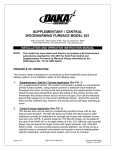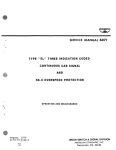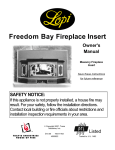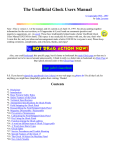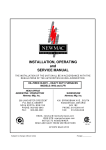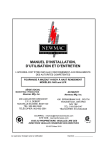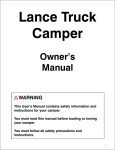Download DAKA 622 Instruction manual
Transcript
SUPPLEMENTARY/CENTRAL
WOOOSURNING FURNACE MODEL 622
DAKA Corporation' 955 Industrial St NE • Pine City, Minnesota' 55063
Phone (320) 629-6737 • Fax (320) 629-3677 • www.dakacorp.com
INSTALLATION AND OPERATION INSTRUCTION MANUAL
NOTE:
These models have been tested and listed in accordance with
Underwriters Laboratories standard UL 391 for Solid Fuel Central and
Supplementary Furnaces by Warnock Hersey International, Inc.
ICBO Report No. TL116; NER Qa219.
PRINCIPLE OF OPERATION:
These furnace models are designed for conventional up flow residential central forced
air heating systems, to be installed in either of the following ways:
1.
Supplementary "Add-On" Furnace Application (See FIG. 1)
As a supplementary furnace, these models are connected in parallel to a
conventional primary furnace system, using present ductwork to distribute woodheated air throughout the home. As long as the heat produced by the
supplementary furnace keeps the living area temperature above the setting on the
primary furnace wall thermostat, the primary furnace should not burn any gas, oil
or use any electricity beyond that required to run the primary distribution blower.
Should the wood fire fail to provide sufficient heat, however, the primary furnace
will begin operating as usual.
2.
Central Furnace Application (See FIG. 2)
This furnace also may be used as a freestanding central furnace, with its own
plenums and ductwork. The double 550-cfm blowers provided with this furnace are
often sufficient to provide air distribution for average size homes with relatively
normal size duct runs. Note: A single 1580-cfm side mounted blower may be
required for larger homes with longer ductwork. As wood burning requires periodic
attention, use of this unit as a central furnace is somewhat inconvenient and requires a second heating system (electric baseboard, vented gas room heaters,
etc.) to act as a backup.
Page 1 of 17
DAKA Furnace Model 622
2008 Edition
Rev 1: 7-6-11
CAUTIONARY NOTES:
1. This furnace is designed for use only in conventional up flow systems and must
deliver heated air to a supply (warm air) plenum - never to ductwork. The warm
air supply from this furnace must never be connected to the cold-air return inlet of
a central primary furnace, as a possibility exists of components of the central
furnace overheating and causing the central furnace to operate other than as
intended.
2. Installation of this unit must be performed by a qualified installer familiar with
.
solid-fuel systems
3. This furnace must be connected to a minimum 6" listed Type HT (high
temperature) appliance type chimney or a code-complying tile-lined
masonry chimney. Connection to a chimney flue serving another appliance
is prohibited.
4. A barometric regulator/damper may be used in the chimney connector (smoke
pipe leading to chimney flue) and must be set to maintain no more than .06"
water column updraft (DAKA barometric regulator #283 with adjustable settings
available at extra cost.)
5. Installation of this furnace in mobile homes or garages is prohibited.
6. This furnace must be installed on a non-combustible floor surface such as
concrete or 3/8" asbestos millboard. This surface must extend at least 16" in front
and 8" to side of DAKA furnace, under the chimney connector and at least 2" to
each side of connector. Clearances to combustible surfaces are:
To side wall:
To back wall:
To front wall:
18"
32%"
48"
Flue to back wall:
Flue to side wall:
23"
27"
See FIG. 3 for ductwork clearances and FIG. 4 for wall clearances. For more
information, including instructions for installations requiring reduced clearances,
please write for publication 211 from National Fire Protection Assn., Inc.,
Publications Dept., 1 Battery Park, Quincy MA 02169-7471 or visit their website
at www.nfpa.org.
7. Check local building and mechanical codes prior to installation to insure
conformance with all requirements. Review home insurance policy for coverage.
8. Chimney connector must be of minimum 24-ga. pipe with each section joined with
three sheet metal screws, with all fissures sealed with furnace cement. Do not
use galvanized pipe as the coating could melt and cause toxic fumes.
Page 2 of 17
DAKA Furnace Model 622
2008 Edition
Rev 1: 7-6-11
9. These furnaces have been designed to operate with a maximum warm air duct
pressure of 0.2 11 water column and a maximum warm air duct temperature of
200°F. When used in a supplementary "add-on" mode, check the nameplate on
the primary furnace to determine compatibility.
10. When any supplementary furnace is connected in parallel to an existing primary
central furnace, a back-draft damper must be installed in the plenum of the
primary furnace below the warm air inlet from the supplementary furnace to
prevent the primary furnace from operating in an unintended manner. See FIG. 1
for an illustration of the position of this damper.
DANGER - RISK OF FIRE OR EXPLOSION! DO NOT BURN GARBAGE,
GASOLINE, DRAIN OIL OR OTHER FLAMMABLE LIQUIDS.
WARNING - RISK OF FIRE! DO NOT OPERATE WITH FLUE DRAFT EXCEEDING
.06" WATER COLUMN. DO NOT OPERATE WITH FUEL LOADING OR
ASH REMOVAL DOORS OPEN. DO NOT STORE FUEL OR OTHER
COMBUSTIBLE MATERIAL WITHIN MARKED INSTALLATION
CLEARANCES. INSPECT AND CLEAN FLUES AND CHIMNEY
REGULARLY.
CAUTION - HOT SURFACES! KEEP CHILDREN AWAY. DO NOT TOUCH DURING
OPERATION. MAXIMUM DRAFT MARKED ON NAMEPLATE.
Disposal of Ashes
Ashes should be placed in a metal container with a tight-fitting lid. The closed container
of ashes should be placed on a non-combustible floor or on the ground, well away from
all combustible materials, pending final disposal. If the ashes are disposed of by burial
in the soil or otherwise locally dispersed, they should be retained in the closed container
until all cinders have thoroughly cooled.
Creosote - Formation and Need for Removal
When wood is burned slowly, it produces tar and other organic vapors, which combine
with expelled moisture to form creosote. The creosote vapors condense in the relatively
cool chimney flue of a slow-burning fire. As a result, creosote residue accumulates on
the flue lining. When ignited this creosote makes an extremely hot fire.
The chimney connector and chimney should be inspected at least twice monthly during
the heating season to determine if a creosote buildup has occurred. If creosote has
accumulated it should be removed to reduce the risk of a chimney fire. Use of a smoke
vent thermometer to monitor stack temperature is recommended.
Page 3 of 17
DAKA Furnace Model 622
2008 Edition
Rev 1: 7-6-11
INSTALLATION INSTRUCTIONS:
I. UNPACKING
Remove all component parts from firebox for assembly; check piece count against
parts list on last page of this manual. NOTE: Remove firebrick from carton
while still within firebox. Do NOT attempt to lift full carton.)
Parts shortage:
If carton was sealed when purchased, call or write factory
immediately. Provide model number and serial number of
furnace, found on front mounted data plate, along with a
description and quantity of missing parts. Replacements will
be shipped. If carton was purchased unsealed, contact store
for missing parts.
Concealed Damage: If any components have been damaged in transit, advise the
dealer from whom the furnace was purchased of the nature
of the problem, so that a freight claim can be filed.
II. FURNACE ASSEMBLY (Refer to Parts List on page 15)
A. Attach fire door (1) to hinge bracket using hinge pin. IMPORTANT: Refer to
Instructions in Hinge Assembly Bolt Bag for proper installation. Note that door
features a double latch operation to limit initial swing of door to 1" on opening.
Continue turning handle clockwise beyond 3 o'clock position to permit full opening
of door. Close door with handle in same position; rotate counterclockwise to lock.
B. Insert thermal gasket (6) between ash door (5) and ash pan (7) front, and
assemble using two 1/4" bolts and nuts provided.
C. Insert Smoke Bypass Damper rod (8) through small hole above fire door, handle
pointing up, and run rod directly back onto smoke baffle plate inside firebox.
Reaching in through fire door opening, screw one large nut onto threaded rod all
the way to the end of the thread. Insert threaded rod end into the hole on the
upright plate on the Smoke Bypass Damper sliding plate, keeping the spring
handle upright. Screw on the 2 nd large nut and tighten fully.
D. Remove cast-iron grate (10) from firebox. Proceed to install firebricks (15) along
sides and back of firebox, starting at the front, by slipping brick under retaining
angle iron and standing them upright on the grate support rails.
CAUTION:
FIREBRICK MUST BE INSTALLED CORRECTLY OR
HEAT DAMAGE MAY OCCUR.
E. Reinstall cast-iron grate in firebox, reinforcing ribs down, resting on side rails.
Insert 3" x 13%11 X %" steel grate spacer (11) at rear of grate.
F. Attach Draft Blower Adapter Plate (21) to front of furnace below fire door using six
No. 12 x W' screws provided, and then attach 60-cfm draft blower (9) to adapter
plate using three No. 12x %" screws. TIP: Put a drop of oil on each screw
thread to ease insertion in heavy-gauge steel.
Page 4 of 17
.
I
DAKA Furnace Model 622
2008 Edition
Rev 1: 7-6-11
G. Install two 550-cfm blowers (14) on back offurnace using four No. 12 x %" screws
provided.
H. Furnace is shipped with air jacket already fitted and installed. If it has worked loose
during shipping or unpacking, do the following:
1. Remove air jacket top (15) by lifting up from front to back only, not side to side.
2. Ensure that bottom air jacket panel (16) is fully seated between lower bottom
support angles.
3. Ensure that channels welded on air jacket sides (17) engage the lower support
channels, and that the side panels are pressed tightly onto furnace around the
front and back corners.
4. Reinstall the air jacket top from back to front, making sure that all top edges of
each of the air jacket sides are inside of top.
5. Install Swing Plate (19) on hooks inside combustion chamber above Fire door
opening, with bent edge inward.
III. FURNACE CONTROL CENTER ASSEMBLY - See FIG. 6 & 6A Wiring Schematic
NOTE: Furnace is designed for installation with supply connection on left side;
should right side supply connection be preferred, it is possible to exchange side air
jacket panels, but conduit and wiring provided will not be usable then, and will
have to be replaced locally.
A. On left side air jacket panel, locate the 3/4" hole toward top of panel.
B. Remove cover on Fan Control. Using three 1%" tube spacers provided,
proceed to mount the Fan Control (4) to the side of the panel, using No. 12 x
2" screws provided. Fan Control is to be held 1%" away from air jacket side by
tube spacers to provide thermal protection for electronic components.
C. Approximately 8" below Fan Control are four pre-punched holes. Mount
Junction Box Ring (2) here, using two No. 12 x 2" screws through slots on back
of ring. Remove one knockout on top of ring and two knockouts on bottom.
Install Straight Conduit Connectors provided for unit wiring.
D. Mount Snap Disc Operating Control (20) on side of furnace within Junction Box
Ring, using two No. 12 x %" screws in pre-punched holes.
E. Insert pre-installed wiring from Fan Control into top center knockout on
Junction Box. Make sure straight conduit connector is in place first.
F. Connect conduit from front Draft Blower to Junction Box. Remove top
knockout from small Junction Box on front draft blower housing. Insert 90°
conduit connector. Locate the 34" long flex conduit that contains 1 red
and 1 white wire. . Attach flex conduit and make wire connections
according to Wiring Schematic in FIG. 6 & 6A.
G. Connect conduit from Rear Blowers to Junction Box. Remove side knockout
on Junction Box on rear blower housing. Insert 90° Conduit Connector.
Locate the 34" long flex conduit that contains 1 brown and 1 white wire.
Attach flex conduit and make wire connections according to Wiring
Schematic in FIG. 6 & 6A.
t
Page 5 of 17
DAKA Furnace Model 622
2008 Edition
Rev 1: 7-6-11
IV. WIRING INSTRUCTIONS - See FIG. 6 & 6A for Wiring Schematic
NOTE: For power supply connections, use No. 14 AWG or larger wires
acceptable for at least 105°C. Shut Off All Power While Installing.
A. Attach approved conduit carrying 3-wire 120V AC 15 amp service to any unused
knockout hole on J-box ring with conduit connector (not included for field wiring
connections).
B. Make all wiring connections per the schematic in FIG. 6 & 6A, making all
connections shown with wire nuts provided. Check all wiring connections for
tightness and electrical safety.
C. Tuck all wires into J-Box Ring, and install Transformer/Relay as J-Box cover.
Reinstall cover plates on blower junction boxes.
V. CONNECTIONS TO DUCTWORK
A. For Use As A Supplementary "Add-on" Furnace - See FIG. 1
NOTE: SUPPLY PLENUM MUST BE METAL! A back draft damper must be
installed in the warm-air supply plenum of the primary furnace below the
point where the warm air ductwork connection from the DAKA furnace
enters the plenum. Actual design and installation procedure for such a
back draft damper is left to the installer, due to the large number of plenum
configurations involved. See FIG. 1 & FIG. 5 for illustration of placement.
1.
Mark and cut out two 8" round holes in the side of the supply (warm air) plenum
of the primary furnace.
IMPORTANT: Verify beforehand that sufficient clearance is available above
air conditioner coils, etc. If sufficient clearance is not available, air
conditioner coil may have to be moved to a second plenum with diversion
baffles for summer use.
2.
Attach each 90° sheet metal elbow to one end of straight 8" pipe. Insert elbow
into supply plenum of primary furnace with outlet pointing upward. Slip collar
over straight end of 8" pipe and push up tight against supply plenum for a good
air seal. See FIG. 1 & FIG. 5.
IMPORTANT: The 90° elbows within the supply plenum forms a venturi to
extract air from DAKA furnace when primary furnace blower comes on. An
absence of these elbows will cause backpressure down the warm air pipe to
the DAKA furnace, adversely affecting heat distribution, and possibly
damaging the DAKA furnace. If space prohibits installation of 90° elbow as
recommended, see FIG. 5 for alternate designs.
Page 6 of 17
DAKA Furnace Model 622
2008 Edition
Rev 1: 7-6-11
3.
Connect cold air return of primary furnace to DAKA filter box using a minimum 10"
diameter pipe.
NOTE: After attaching warm and cold air supply and return pipes to
primary furnace, check entire system to insure that static pressure remains
unaffected. Verify horizontal duct clearances (see FIG. 3).
B. For Use As A Central Furnace - See FIG. 2
1.
2.
3.
Install a minimum 16" x 16" plenum (PLENUM MUST BE METAL) on air jacket
top with tin snips or sabre saw as needed, using starting collar to attach.
Install ductwork with proper clearances to combustibles in accordance with local
bUilding codes.
Make sure to connect a cold air return line to the back of the cold air filter box that
was supplied with your new 622. Install and assemble the cold air filter box
according to instructions.
VI. CONNECTING DAKA FURNACE TO CHIMNEY
Mount and secure 6" non-galvanized smoke pipe, 24-ga. or heavier, to rear
smoke outlet on DAKA furnace. Continue same gauge single-wall pipe to
chimney connection, with following safety rules in mind:
1.
2.
3.
4.
5.
6.
7.
8.
A barometric regulator should be installed in smoke pipe at least 18" from
furnace, to permit adjustment of chimney draft to a maximum of .0611 water
column draft. Barometric Regulator No. 283 with adjustable draft setting is
available through DAKA for this purpose.
Smoke pipe should maintain a minimum 18" clearance to all combustibles
and should never pass through walls or ceilings. Use proper thimbles for
those passages.
Heat reclaimers, fins or the like should not be used on smoke pipe, as they tend
to cool flue gases and add to creosote formation on stoves and furnaces of
advanced airtight design.
All joints of chimney connector pipe should be secured with a minimum of three No.
7 sheet metal screws & further sealed with furnace cement to maintain good draft.
Smoke pipe should normally be installed with male ends leading from chimney to
furnace; should runny creosote be formed in chimney connector, it will then return
through pipe to furnace without dripping out of joints.
Maintain a minimum of 1/411 per foot of pipe rise to chimney connection; the
steeper the rise, the more easily draft will be maintained, generally.
Avoid the use of 90° elbows in any chimney connector, as they adversely
affect draft. If 90° elbows must be used, do not install more than two in any
chimney connector.
Adequate combustion air must be provided in furnace area to prevent poor firing
and smoking. Keep a window cracked open in furnace area or install dryer-type
4" vent to bring in fresh air.
Page 7 of 17
DAKA Furnace Model 622
2008 Edition
Rev 1: 7-6-11
VII. OPERATING CONTROLS
A. Fan Controls
The fan control on the side of the DAKA furnace has a rotating thermostat disc.
Holding the disc firmly in place, adjust the three tangs for these three settings from
left to right as follow:
FAN OFF - 90°, FAN ON - 130°, LIMIT - 200°.
These Fahrenheit settings will cause the 550-cfm back blowers on the DAKA furnace
to turn ON when the temperature within the air jacket rises to 130°, and OFF when
the temperature within falls below 90°. The limit setting will shut off the front 60-cfm
draft blower should an unsafe bonnet temperature over 200°F be reached. The
blower will be reactivated automatically when the temperature falls to 160°F.
While this fan control is designed for fully automatic operation, you can turn the back
blowers on manually at any time by pushing white button on fan control in. Pulling
button out will turn the blower off, unless the heat within the air jacket is above the
"FAN ON" setting of the dial, in which case the blowers will continue to run until the
temperature drops.
The snap-disc control inside the J-box ring is an operating control for the 60-cfm
draft blower, with a built in range of 190° OFF 170° ON, to prevent furnace
overheating. During normal operation this control may be activated frequently and is
designed to help level the furnace heat output.
IMPORTANT: In a supplementary "Add-On" installation, the blowers on the
DAKA furnace can be used as circulation blowers for heating the house.
They also can be used in conjunction with your primary furnace blower to
boost air circulation in large ductwork systems. An optional fan control may
need to be located in supply plenum to turn primary blower on and offwhen
heat is received from the DAKA furnace. (See FIG. 1 for fan control location).
B. Living Area Wall Thermostat Location (22)
The Honeywell T812A1002D thermostat should be installed in any ground floor
room on an inside wall, preferably beside the thermostat governing the primary
furnace, which should be set approximately 5° lower than the DAKA thermostat.
When falling room temperatures call for heat, the DAKA thermostat turns on the 60cfm front draft blower on the DAKA furnace; the additional combustion air increases
the heat output until the DAKA room thermostat signals the blower to cut off.
Combustion air then reduces to a maintenance level with a relatively low heat
output, ready for the next firing cycle. Should there be insufficient fuel to increase
the room temperature as called for, the primary furnace will fire when the
temperature falls to the 5° lower setting. The DAKA draft blower will continue to run;
however, to turn it off, lower the DAKA room thermostat setting below that of the
primary furnace.
Page 8 of 17
DAKA Furnace Model 622
2008 Edition
Rev 1: 7-6-11
IMPORTANT: Normal operation will produce flue gas temperatures in the
300°· 600°F range. If higher or lower operating temperatures are normally
obtained, increase or decrease the barometric draft control setting and room
thermostat setting to bring temperatures to within range. Too cool a flue gas
temperature can result in heavy creosote formation, while too hot a
temperature increases danger of chimney fire.
C. Smoke Bypass Damper
Due to the extra long smoke baffle in this model, designed to create the longest
possible flame path for maximum heat extraction, a sliding smoke bypass damper
plate, controlled by the damper rod over the fire door has been provided. Before
opening fire door for reloading or checking fire, pull the damper rod out fully to allow
the smoke to exit at rear of chamber, rather than rolling forward and possibly spilling
into the room. After closing fire door, push damper rod fully in to seal rear vent.
VIII. EMERGENCY OPERATION INSTRUCTIONS
A. Operation During Power Failure
1. Remove furnace filter(s) to prevent fire hazard.
2. Continue firing the fire with smaller loads, more frequently tended.
3. Use extreme care and vigilance during power failure to keep furnace from
overheating, which could cause severe warpage or breakage.
4. The air jacket top and side may be removed to provide more radiant heat to
help cool the firebox.
CAUTION: DO NOT expect the DAKA furnace to keep the house as warm
during a power failure as when power is on. Do no attempt to
increase heat output by opening ash door or fire door.
B. In Case of a Chimney Fire:
1. Call the fire department immediately.
2. Reduce room thermostat to lowest point to shut off draft blower. Use chimney
fire extinguishing flares if you have them. (Available at your local home store
or fireplace and woodstove shops).
3. After chimney fire, do not attempt to use chimney again until a professional
inspection is made to determine safety.
Page 9 of 17
DAKA Furnace Model 622
· 2008 Edition
Rev 1: 7-6-11
I----------~i
IX. MAINTENANCE OF YOUR DAKA FURNACE
A. Fueling Procedure
Fill with cordwood (and/or coal, if applicable) to the top of the firebrick. Before
burning coal, you must have a coal burning grate and a fire door equipped with a
spin draft (available from dealer or direct from the factory).
B. Flue Pipe and Chimney
,
These must be checked frequently during heating season, and deposits of soot
and creosote over 1/8" thick removed using stiff-wired brushes designed for the
job. Professional cleaning by a chimney sweep at least once a season is highly
recommended.
C. DAKA Furnace Blowers
Both the front and rear blowers on your new DAKA Furnace Model 622 have
permanently lubricated bearings. Re-Iubrication is NOT required. Vacuum away
dust and dirt on motor air inlets and also on blower impellers at least once each
season. CAUTION: TURN OFF ALL POWER TO UNIT BEFORE CLEANING
AND LUBRICATION.
D. Fire Chamber and Ash Pan
Check ash pan every few days and safely dispose of ashes. Keep ashes from
building up on grate and interfering with combustion airflow from below. At end of
heating season, clean out all residual ashes from furnace. The moisture they
contain could rust your furnace over the summer months, thereby shortening the
life of the unit.
X. TROUBLE SHOOTING
A. Problem: Smoke puff back when loading, poor burning, insufficient heat
Solutions:
1. Insufficient draft--debris or creosote could be blocking flue; inadequate chimney
height or design could be causing downdrafts; check chimney connector for air
leaks and seal with furnace cement; adjust barometric regulator to higher setting.
2. Insufficient make-up air-- the house could be so well insulated that infiltration air
is not getting in to replace air used in combustion; open a window slightly in
furnace room or install a vent to the outside in furnace area.
B. Problem: Poor heat throughout house while burning wood
Solutions:
1. Poor quality wood--burn only wood which has been air-dried for at least six
months, preferably a year or more. Use hardwoods such as hickory, oak, maple,
etc. for highest heat value per load.
2. Check to insure that all cold air return vents are open and not blocked with
furniture, etc.
3. Make sure that all duct joints are airtight, and apply duct tape to seal.
4. Check flue gas temperature--normal operating range is 300°-600°F. Lower
temperature would indicate insufficient draft or inadequate combustion air.
5. Insure that primary furnace blower is turning on to distribute heat effectively.
Lower "FAN OW setting on primary furnace fan control to start circulation earlier.
Page 10 of 17
DAKA Furnace Model 622
2008 Edition
Rev 1: 7-6-11
C. Problem: Paint Discoloration (whitish appearance)
Solution:
Paint is rated for 900°F surfaces, and overheating of furnace will cause a whitish
appearance on outside of combustion chamber surfaces; reduce chimney draft to
control overheating. NOTE: To cover discoloration, obtain a high-temperature flat
black spray paint from hardware or fireplace shop.
If problems persist, or help is needed in installation or operating of furnace,
contact:
Customer Service Department
DAKA Corporation
955 Industrial st. N.E.
Pine City, MN 55063
(320) 629-6737
Page 11 of 17
DAKA Furnace Model 622
2008 Edition
Rev 1: 7-6-11
FIG. 1 - Typical Installation As Supplementary "Add-On" Furnace
Fan Control
L4064B
[J
Primary Furnace
Warm Air Plenum
90 0 Elbows installed
inside plenum
6" Minimum Listed Type HT
Chimney serving DAKA
Furnace Only
(See FIG. 5 for alternatives)
Location of Fixed
Back Draft Damper to
be installed on
Primary Furnace
Twin 8" round
warm air outlet
pipes
Barometric Regulator
Primary Furnace
+--- (natural gas, electric, oil)
Minimum 12" Round Cold
Air Return Pipe Connected
To Filter Box Inlet
FIG. 2 - Typical Independent Central Furnace Installation
A - STACKHEAD
B - VERTICAL STACK
(2 STORY HOUSE)
C - REGISTER BOOT
0-6" DIA. OR LARGER HEAT PIPE
E - RECTANGULAR DUCT
F - RECTANGULAR DUCT REDUCER
G - SIDE DUCT STARTING COLLAR
H - END BOOT (RIGHT OR LEFT)
I - DUCT DAMPER
J - 50° SHORT ELBOW
K - BASEMENT HEAT REGISTER
L - UNIVERSAL OR TOP TAKE-OFF
M - DUCT STARTING COLLAR
(RECTANGULAR)
N - COLD AIR RETURN GRILL
0- COLD AIR PLENUM
P - WARM AIR PLENUM
Q - DUCT END CAP
R - COLD AIR RETURN DUCT
Page 12 of 17
DAKA Furnace Model 622
CAUTION:
SEE DUCT CLEARANCES FOR
PROPER INSTALLATION.
CHECK LOCAL CODES.
2008 Edition
Rev 1: 7-6-11
FIG. 3 - Clearances from Horizontal Warm Air Ducts
C~NTRAL" FUIlNACf
\./ARM AIR
1--~Ll>NUM
ro' ----lI*f---aY~R ro'---+
From Sides and Top of Warm Air Plenum - 6"
From Horizontal Ducts within 6 Ft. of Plenum - 6"
From Horizontal Ducts beyond 6 Ft. of Plenum - A"
FIG. 4 - Clearances to Combustibles
'//////Y/.PVWAt..L// /'" / / /'" /" / .........
. ...
~
t
{
,.
,,'o"
c:
K'
Je. •
00
l'
1':"
*
IN'
~
to
L.
.,/
.-/
/'"
.......
FIG. 5 - Alternative Warm Air Plenum Pipe Insert Designs
""-EXlS11HG aECJRIcjrJS/OIL
CEUfItI,l. HEfiTltlG FURNACE
Page 13 of 17
DAKA Furnace Model 622
2008 Edition
Rev 1: 7-6-11
FIG. 6 - Wiring Schematic
IN CONTROL~
III
UNIT WIRING
LOAD
LOAD
-FAN
L1MITLINE
TRANSFORMER RELAY
(MOUNT ON FACE OF
JUNCTION BOX)
~11E
~
\!!
LINE
FJELD WJRING
I
BLla<
RED L--l.-._-----.JL......J
~.,
.--1-------1----1-+-+.., ~
550 CFM
BLOWER (BACK)
~
---------. r------,
JUNCTION 80X/
RING
GROUND
SCREW
~ r~
1
SERVICE
i
1
::
1
1
~
ili
i1
1
1 "
1 ~
1
120 VAC
15 AMP
1
i
L__ ,
\
I
i
DIAGRAM 1 WIRING SCHEMATIC
Iii
DAKA FURNACE
!3!j ::i
PINE
955 INDUSTRIAL SlREET N.E.
m.
an, MN.
~!506J
320-S29-/37J7
FAX. 320-629-3677
Page 14 of 17
DAKA Furnace Model 622
2008 Edition
Rev 1: 7-6-11
FIG. 6A - Wiring Schematic
.,
WHITE
WIRE
3 BLAcKWIRES:
~.1 FROM TRANFORMER
- 1 FROM FAN CONTROL' .
- 1 FROM POWE~ SUPPLY
WIRING FRONT ..
DRAFT BLOWER
~~"
~~
,,'
.~2J'
Page 15 of 17
DAKA Furnace Model 622
2008 Edition
Rev 1: 7-6-11
KEY
No.
1.
2.
3.
4.
5.
6.
7.
8.
9.
10.
11.
12.
13.
14.
15.
16.
17.
18.
19.
20.
21.
22.
Part Description
Fire Door
with Gasket
Junction Box Ring - 4x4 (C)
RelayfTransformer (B)
Fan/Limit Control (B) [34064 assv)
Ash Door Assemblv
Thermal Gasket - Ash Door (A)
Ash Pan Assemblv
Bvpass Damper Rod & Slide Plate
Draft Blower 50 cfm
Cast Iron Grate
Grate Spacer (A)
Firebrick (box of 15)
Hinqe Assemblv (A)
Blower - 550 cfm
Air Jacket - Top Panel
Air Jacket - Bottom Panel
Air Jacket - Side Panel - w/o holes / with holes
# not used
Swing Plate (A)
Opera!inq Control Snap Disc - 190· open (C)
Draft Blower Adapter Plate (B)
Wall Thermostat (8)
Conduit - Short (8") B)
Conduit - Long (34" (B)
Wire Nut - Large (C
Wire Nut, Small (C)
Sheet Metal Screw -#12 x %" (C)
Sheet Metal Screw - #12 x 2" (C)
Hex Bolt, % x % for ash pan (C)
Hex Nut, % for ash pan (C)
Conduit Connector- Straight (C-4), (B-1), (D-2)
Conduit Connector - 90· (C)
Tube Spacer (C) .
Twin Blower Bolt Bag (1 wire set, 2 wire nuts,
1-20" conduit, 2 straight conduit connectors)
Instruction Manual (A)
Part No.
34200
57610204
62630601
58640002
58640001
35100
57610202
35400
57590214/0216
63811142
59650001
57660001
37002
30720
63610004
64590210
64590208
64590209 / 0212
56811158
57590211
58640005
57670603
58640003
62630401
62630405
62630801
62630802
SCT#!212
SCT#122
HB1434
HN14
62670201
62670202
57670204
Qtv
1
1
1
1
1
1
1
1
1
1
1
1
1
1
2
1
1
1ea
1
1
1
1
1
1
2
2
7
17
3
2
2
7
1
3
273B
66700021
1
1
A. Parts Bag #36315 B. Bolt Bag #36310 C. Forced Draft Assembly Box #32300
All other components are individual parts.
Page 16 of 17
DAKA Furnace Model 622
2008 Edition
Rev 1: 7-6-11
LIMITED WARRANTY
DAKA Corporation warrants the combustion chambers of its supplementary
furnaces to be free of defects in material or workmanship for five years from date of
sale; all other components, including electronics, gaskets and grates are covered in
the same manner for a period of one year.
DAKA will repair or replace defective components, at our option, at no charge for
parts and labor, and will pay freight charge for one-way shipment for warranty
claims during first year. In second and subsequent years, only parts and labor will
be provided at no charge. DAKA is not responsible for installation or dismantling
costs.
Warranty void if unit is used in other than residential service connected to
conventional basement-type up flow central heating system, if non-approved fuels
are used in firing of units, or if unit is damaged due to accident, improper
installation or negligence.
For service under this warranty, contact selling dealer or DAKA Corporation,
Customer Service Dept., 955 Industrial St NE, Pine City MN 55063; Telephone
(320) 629-6737.
Implied Warranties including that of merchantability are expressly limited in
duration to the duration of this warranty. DAKA Corporation disclaims any
responsibility for consequential damages. Some states do not allow limitations on
how long an implied warranty lasts, or the exclusion or limitation of incidental or
consequential damages, so this limitation and exclusion may not apply to you.
This warranty gives you specific legal rights, and you may also have other rights
which vary from state to state.
This is our exclusive written warranty.
Page 17 of 17
DAKA Furnace Model 622
2008 Edition
Rev 1: 7-6-11

















